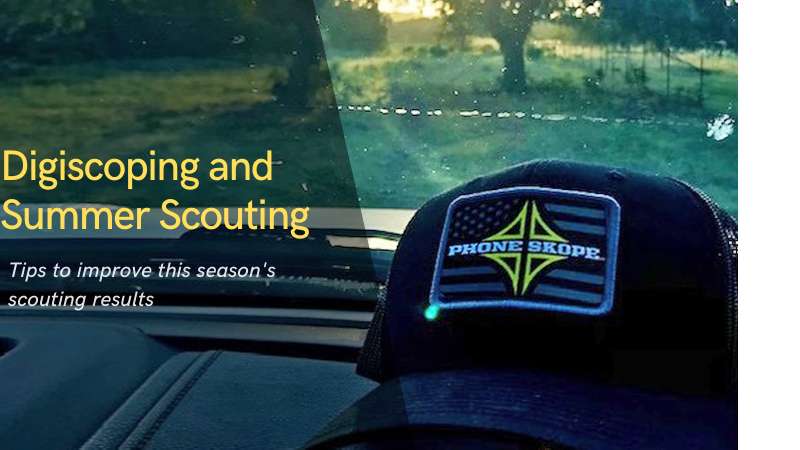According to social media and the all-knowing internet, ultra-serious deer hunters are seemingly everywhere. You know the ones. They talk about chasing these wily creatures all the time, regardless of the season. During the fall, if they’re not hunting, they’re plotting their next trip. During the offseason months, thoughts continue to be filled with tall antlers, new stand locations, and of course, the future whitetail rut. To that end, there are always chores to do for this obsessed bunch. They simply have to be doing deer things, not the least of which is deer scouting – and I’ve learned that the term is used pretty loosely.
When it comes to real scouting, the seasoned are separated from the novice pretty quickly. For most, summer scouting means little more than deploying a few trail cameras and occasionally gawking through binoculars from the truck. Sure, these activities have merit, but at the end of the day, they don’t amount to much.

Digiscoping gear is minimalistic, including mainly your smartphone, optics, and Phone Skope adapter kit.
My deer hunting success increased when I learned the art of digiscoping. While it was rewarding in a few ways, none was bigger than in the area of scouting on the properties I hunted. Why?
Scouting is Hunting
First off, offseason digiscope scouting means you can put your hunting skills to the test. Whitetails are skittish critters, so it’s an opportunity to camo up and experience a real boots-on-the-ground pursuit of them, albeit through the lens of your smartphone camera. Plus, it’s a ton more actionable than clicking through hundreds of trail camera photos on your couch.
Directional Matters
Right off the bat, digiscoping for deer or other game tells you more than trail camera footage. It reveals what direction a deer comes from and how he approaches a specific area. For that matter, it can reveal where they retreat at the end of the day. Translation; it provides you with good intel for future stand locations, as well as optimal entry and exit routes for you as the hunter.
Seeing Other Cool Stuff
I’ve yet to meet a hunter that doesn’t prefer to be outside. Digiscoping allows for great viewing of not only deer but other wildlife. In my world, this entails sightings of wild hogs, turkeys, interesting birds, and a whole slew of other creatures; and don’t forget the sunrises, sunsets, and interesting lighting situations that occur during daylight hours. Capturing nature and wildlife in images and video is a coup and digiscoping brings them closer.

Digiscoping offers opportunities to see a variety of wildlife like these turkeys on a Texas summer digiscope scouting session
Minimized Pressure
Ardent deer hunters know the importance of minimizing human pressure. Repeated trips deep into a property to tend to trail cams quickly elevates the human footprint. This never bodes well when it comes to hunting deer – especially mature bucks. Sure, wireless cameras are more popular these days, but keeping fresh batteries in cameras and a variety of user errors typically rear their ugly head with this method.
Digiscope Scouting Basics
In most climates, offseason scouting means warm, if not blazing temperatures. As such, dressing for comfort is important. Nevertheless, it’s also favorable to blend in. Like with any hunting sit, dress in camo or earth-toned clothing – ideally garments that are sweat-friendly. Further, enhance the ability for long sits by packing water and snacks. Fully charge your phone ahead of time and even consider packing a portable charging bank.
Manage your scent dispersal by playing the wind, as well as pick locations that allow for long-range viewing of popular travel corridors. The magnification afforded by digiscoping allows for such a strategy. Remember, treat these outdoor intel missions like hunting sits. Don’t skimp on the rules simply because you won’t be releasing an arrow or sending a rifle round.
Stay mobile. While it’s okay to pick one location and stick with it, organized venue changes can help you to gather more information. To that end, pack light, and plan for two or three spots to view from. Don’t wander around randomly.

Digiscope scouting can be enhanced by staying mobile and capturing footage from multiple locations. Likewise, it’s more enjoyable when dressing for concealment and comfort.
If not already acclimated, practice setting up your digiscoping apparatus quickly and smoothly. At a minimum, keep your smartphone cradled in your Phone Skope case. Pack a lightweight tripod and nurture the muscle memory associated with setting up your gear at a new location.
Finally, pack two sets of optics; one for digiscoping and one for basic surveying of the landscape. While many hunters will connect their smartphone to a spotting scope to digiscope, any combination of spotting scopes, binoculars, or monoculars does the trick.
If you’re truly a whitetail junkie that seeks to maximize success in the fall, make an offseason digiscoping plan. Discovering your next target buck may be only a viewing session away. Start hunting season early via your optics, smartphone, and Phone Skope Digiscoping adapter kit.
Summer scouting is a great time to Capture.Record.Share…and scout. Put differently, take time to enjoy the outdoors and gather whitetail intel the Phone Skope way.



